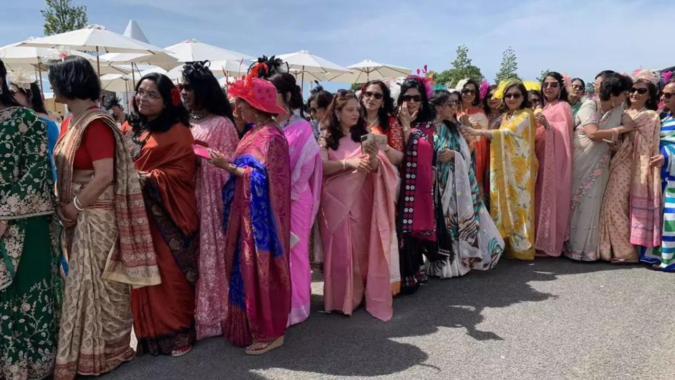The women, each dressed in the traditional sarees from their state, danced to the popular Bollywood song, “Kashmir Main, Tu Kanyakumari”, outside Downing Street. Escorted by traffic marshalls, they passed a guitar busker who was taken aback to see hundreds of saree-clad women stopping to dance to his music.
Two astonished passersby from Dresden, Laura (14) and her mother Luna, told TOI that they had never witnessed anything like this in Germany. “It is beautiful and cool. It’s woman power. They look strong and full of self-respect,” Luna said.
The aim of the saree walkathon was to honour the artisans across India who can spend weeks making one saree and celebrate the different styles and weaves from across India. The women performed folk dances from their state at the Gandhi statue where the walk ended in Parliament Square.
Sulekha Davda, wearing a sequin-covered saree from Gujarat, said, “We are proud to be Indian and British. We still live with our Indian culture here and we want to promote the artisans in India.”
Alka Sehgal Rahulkar was in the Delhi and Haryana contingent, wearing a phulkari chunni, parandi, and maangtika. She said: “Sarees represent my culture and I feel I belong. We are part of London but still carrying our roots with us.”
Chanda Jha from Bihar was in a tussar silk saree from Madhubani. “We want to preserve the tradition of wearing sarees and protect the handloom industry from going extinct, so the next generation knows about it,” she said, pointing out that many Indian women now wear western wear and find sarees difficult to drape.
“In India, our cousins started wearing jeans and we were concerned the next generation would not be used to sarees,” said Rinna Dutta, who was donning a handwoven saree from Murshidabad, West Bengal.
Keralites were showcasing the traditional cream settu mundu, while ladies from Uttarakhand were in their traditional naths (nose rings). The women representing Maharashtra were in nauvari sarees and those from Himachal Pradesh were in kullu print pashmina and Himachali topi (cap) with bling on.
Dr Dipti Jain, the organiser of the event, said: “The whole atmosphere was amazing.”
